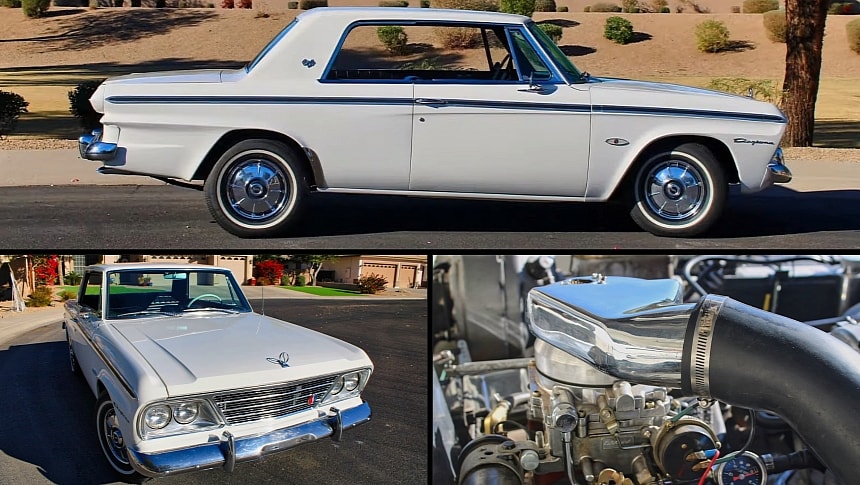Studebaker may be famous for large cars and sporty and luxurious rigs like the Avanti and Golden Hawk, but the company also built a competitive compact. It also developed the first American high-performance vehicles for this class. I'm talking about the Lark.
Studebaker introduced the Lark in late 1958 when the compact market was still in its infancy. Sure, Nash pioneered the segment with the Rambler in 1950, but most carmakers didn't jump on the compact wagon until nearly ten years later. In 1959, Ford launched the Falcon, while Plymouth debuted the Valiant.
The following year, Chevrolet revealed the rear-engined Corvair, while Dodge gained access to the A-body platform and created the Lancer. The Chevy II/Nova did not arrive in showrooms until 1961. The Studebaker Lark debuted before the Falcon and the Valiant, so it pretty much spearheaded the first wave.
It was the brainchild of company president Harold E. Churchill. Realizing that Studebaker couldn't compete with the Big Three in the full-size market, Churchill thought the company would have a brighter future if it focused on smaller vehicles. But while it was notably smaller than a full-size rig, the Lark was surprisingly spacious.
That's because it was designed around the platform of the late-1950s full-sized Studebakers. By reducing the front and rear overhangs and shortening the wheelbase just ahead of the firewall, the Lark had a more compact footprint, but it could still seat six people comfortably.
The Lark was also the first vehicle of its size to have a V8 engine. The 259-cubic-inch (4.2-liter) OHV was offered as early as 1959. In 1961, when the competition began rolling out V8 models, Studebaker added the 289-cubic-inch (4.7-liter) mill to the lineup.
But the boldest move was to drop the Avanti's supercharged 298 V8 in the Lark. With 289 horsepower at its disposal, the Super Lark needed only 7.3 seconds to reach 60 mph (97 kph) from a standing start. Top speed was just as impressive at 132 mph (212 kph) and turned the Super Lark into America's fastest compact car.
Unfortunately, this wasn't enough to save Studebaker, and both the company and the Lark went into the history books in 1966. But fortunately enough, some Larks and Super Larks survived to tell the story.
The unassuming white example you see here is not a Super Lark. It's a 1964 version in Daytona trim, which was the top-of-the-line model in terms of equipment. But while it may look like a Daytona on the outside, this Studebaker is anything but mundane under the hood. That's because it's pretty much a Super Lark as far as oomph goes.
Powered by a 289-cubic-inch V8 bored .030 over and topped by a McCulloch supercharger, this super-clean Studebaker is the Super Lark the company did not offer in 1964. And it has a lot of things to brag about. It's spotless inside and out, drives like a new car, and sounds amazing. It's the perfect orphan classic.
The following year, Chevrolet revealed the rear-engined Corvair, while Dodge gained access to the A-body platform and created the Lancer. The Chevy II/Nova did not arrive in showrooms until 1961. The Studebaker Lark debuted before the Falcon and the Valiant, so it pretty much spearheaded the first wave.
It was the brainchild of company president Harold E. Churchill. Realizing that Studebaker couldn't compete with the Big Three in the full-size market, Churchill thought the company would have a brighter future if it focused on smaller vehicles. But while it was notably smaller than a full-size rig, the Lark was surprisingly spacious.
That's because it was designed around the platform of the late-1950s full-sized Studebakers. By reducing the front and rear overhangs and shortening the wheelbase just ahead of the firewall, the Lark had a more compact footprint, but it could still seat six people comfortably.
The Lark was also the first vehicle of its size to have a V8 engine. The 259-cubic-inch (4.2-liter) OHV was offered as early as 1959. In 1961, when the competition began rolling out V8 models, Studebaker added the 289-cubic-inch (4.7-liter) mill to the lineup.
But the boldest move was to drop the Avanti's supercharged 298 V8 in the Lark. With 289 horsepower at its disposal, the Super Lark needed only 7.3 seconds to reach 60 mph (97 kph) from a standing start. Top speed was just as impressive at 132 mph (212 kph) and turned the Super Lark into America's fastest compact car.
Unfortunately, this wasn't enough to save Studebaker, and both the company and the Lark went into the history books in 1966. But fortunately enough, some Larks and Super Larks survived to tell the story.
The unassuming white example you see here is not a Super Lark. It's a 1964 version in Daytona trim, which was the top-of-the-line model in terms of equipment. But while it may look like a Daytona on the outside, this Studebaker is anything but mundane under the hood. That's because it's pretty much a Super Lark as far as oomph goes.
Powered by a 289-cubic-inch V8 bored .030 over and topped by a McCulloch supercharger, this super-clean Studebaker is the Super Lark the company did not offer in 1964. And it has a lot of things to brag about. It's spotless inside and out, drives like a new car, and sounds amazing. It's the perfect orphan classic.











